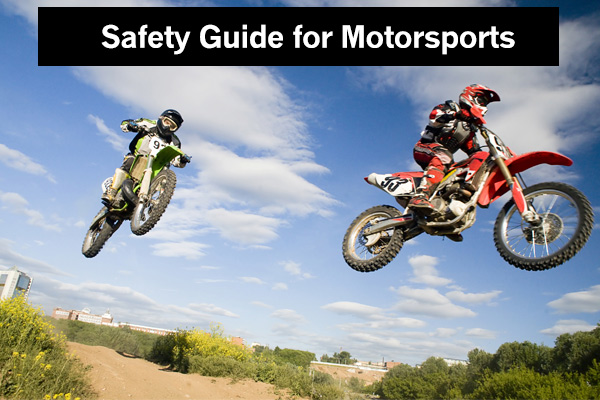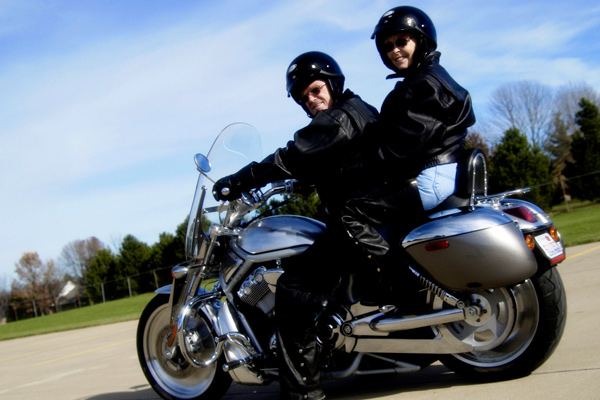
Motorsports can include a broad range of motorized vehicles, operated recreationally or competitively in organized events. When operating a motor vehicle, either off-road or on the highway, follow safety recommendations to reduce the incidence of injury. Manufacturers provide safety recommendations based on the operation of specific vehicles. Government researchers also conduct research regarding typical use and conditions to provide consumers with recommended safety guidelines.
Motorcycles
Riding a motorcycle on the streets and highways involves a high degree of defensiveness for safety. Being seen by motorists should be a high priority, because it's common for other drivers to miss seeing motorcycles on the road. Wear bright clothing to increase visibility. A white or light colored helmet is usually more visible than a dark colored helmet. Affix reflective adhesive strips to a jacket and to your motorcycle to increase visibility. Always use your motorcycle headlight so other motorists are more likely to see you. Adopt defensive driving strategies, such as increasing the space between you and other vehicles and riding in lanes where other motorists are most likely to see you. Take classes to learn how to ride a motorcycle safely and learn as much as possible about riding your specific motorcycle.
- Motorcycle Safety Guide: Table of Contents
- Motorcycle Safety
- Motorcycle Operator Manual
- General Guidelines For Riding A Motorcycle Safely
- Operating a Motorcycle
- Operator Manual for Motorcycles

Dirt Bikes
A dirt bike is a motorcycle designed for off-road riding. Learn the features and controls of a specific dirt bike prior to riding it. Take a class to receive detailed instruction for how to operate your dirt bike and for off-highway riding in general. Never ride a dirt bike alone, in case of an accident. It's also important to use safety gear and equipment at all times to minimize serious injury in the event of an accident, including a helmet, goggles, a neck brace, a chest protector, and protective clothing. Survey the terrain where you will be riding prior to riding to ensure you know what to expect. Avoid riding techniques and trails that surpass your skill level, to avoid accidents. If you find yourself in a situation that exceeds your skills or comfort level, move off the trail and resume riding in a different location. Supervise children's operation of dirt bikes carefully to help reduce injuries.
- Which Helmet for Which Activity?
- OHV Regulations for Youth Riders
- OHV Laws and Places to Ride
- Tips and Practice Guide for the Off-Road Motorcyclist
- Florida Off Highway Vehicle
- Owning and Operating an ATV or Dirt Bike in Massachusetts

ATVs
All-terrain vehicles are designed for off-highway use only. Before operating an ATV, familiarize yourself completely with operation of the vehicle. Consider receiving formal instruction to help you learn safe operation of the ATV. When driving an ATV, always wear full protective gear, including a helmet, goggles, gloves, boots, and clothing with long sleeves and long pants. Survey a riding area carefully prior to driving an ATV over it to prepare yourself for all features of the trail. Avoid driving an ATV on a paved road, except for situations that require you to cross a road or highway. Driving an ATV on a paved highway can be exceedingly dangerous because motorists will often miss seeing the ATV. Always follow ATV passenger guidelines, never allowing more passengers on an ATV than the designated number. Supervise children's use of ATVs carefully to reduce the incidence of injury.
- ATV Safety Training
- ATV Safety/Helmet Fitting Program Evaluation Guide
- Off-Highway Vehicle Reference Guide
- ATVs: Information for Owners and Operators
- All-Terrain Vehicle Injury in Children: Strategies for Prevention
- Tips and Practice Guide for the All-Terrain Vehicle Rider
- ATV Safety Guide
- Guide to Responsible ATV Riding

Automobiles
Cars are designed for road and highway use. Modern design of cars incorporates stringent safety features to help reduce accidents and to keep occupants safe in the event of accidents. Different car makes and models have different features and designs, however. The government and the insurance industry conduct crash tests to see how cars perform in accidents. Manufacturers may adjust car designs after receiving information from crash tests to enhance safety. Drivers also play an important role in automobile safety. Defensive driving, following traffic laws, and avoiding distractions while driving are effective ways to ensure safer operation of motor vehicles.

